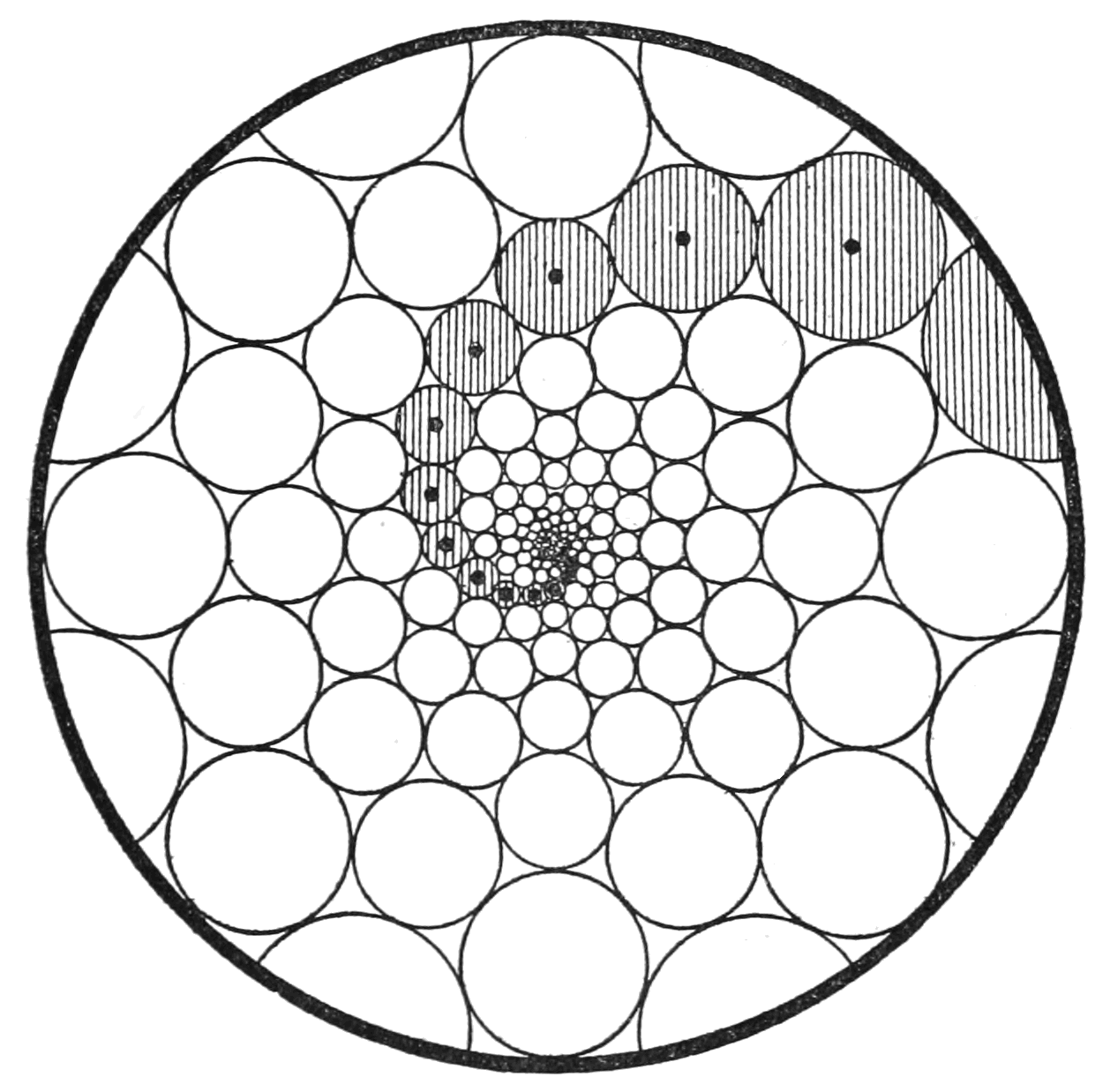
In the mathematics of
circle packing
In geometry, circle packing is the study of the arrangement of circles (of equal or varying sizes) on a given surface such that no overlapping occurs and so that no circle can be enlarged without creating an overlap. The associated ''packing den ...
, a Doyle spiral is a pattern of non-crossing circles in the plane in which each circle is surrounded by a ring of six
tangent circles
In geometry, tangent circles (also known as kissing circles) are circles in a common plane that intersect in a single point. There are two types of tangency: internal and external. Many problems and constructions in geometry are related to tangen ...
. These patterns contain spiral arms formed by circles linked through opposite points of tangency, with their centers on
logarithmic spiral
A logarithmic spiral, equiangular spiral, or growth spiral is a self-similarity, self-similar spiral curve that often appears in nature. The first to describe a logarithmic spiral was Albrecht Dürer (1525) who called it an "eternal line" ("ewi ...
s of three different shapes.
Doyle spirals are named after mathematician
Peter G. Doyle
Peter may refer to:
People
* List of people named Peter, a list of people and fictional characters with the given name
* Peter (given name)
** Saint Peter (died 60s), apostle of Jesus, leader of the early Christian Church
* Peter (surname), a sur ...
, who made an important contribution to their mathematical construction in the late 1980s or However, their study in
phyllotaxis
In botany, phyllotaxis () or phyllotaxy is the arrangement of leaf, leaves on a plant stem. Phyllotactic spirals form a distinctive class of patterns in nature.
Leaf arrangement
The basic leaf#Arrangement on the stem, arrangements of leaves ...
(the mathematics of plant growth) dates back to the early
Definition
A Doyle spiral is defined to be a certain type of
circle packing
In geometry, circle packing is the study of the arrangement of circles (of equal or varying sizes) on a given surface such that no overlapping occurs and so that no circle can be enlarged without creating an overlap. The associated ''packing den ...
, consisting of infinitely many circles in the plane, with no two circles having overlapping interiors. In a Doyle spiral, each circle is enclosed by a ring of six other circles. The six surrounding circles are tangent to the central circle and to their two neighbors in the
Properties
Radii
As Doyle the only way to pack circles with the combinatorial structure of a Doyle spiral is to use circles whose radii are also highly Six circles can be packed around a circle of radius
if and only if there exist three positive real numbers so that the surrounding circles have radii (in cyclic order)
Only certain triples of numbers come from Doyle spirals; others correspond to systems of circles that eventually overlap each
Arms
In a Doyle spiral, one can group the circles into connecting chains of circles through opposite points of tangency. These have been called ''arms'', following the same terminology used for Within each arm, the circles have radii in a doubly infinite
geometric sequence
A geometric progression, also known as a geometric sequence, is a mathematical sequence of non-zero numbers where each term after the first is found by multiplying the previous one by a fixed number called the ''common ratio''. For example, the s ...
or a sequence of the same type with common multiplier
In most Doyle spirals, the centers of the circles on a single arm lie on a
logarithmic spiral
A logarithmic spiral, equiangular spiral, or growth spiral is a self-similarity, self-similar spiral curve that often appears in nature. The first to describe a logarithmic spiral was Albrecht Dürer (1525) who called it an "eternal line" ("ewi ...
, and all of the logarithmic spirals obtained in this way meet at a single central point. Some Doyle spirals instead have concentric circular arms (as in the stained glass window shown) or straight
Counting the arms
The precise shape of any Doyle spiral can be parameterized by three
natural number
In mathematics, the natural numbers are the numbers 0, 1, 2, 3, and so on, possibly excluding 0. Some start counting with 0, defining the natural numbers as the non-negative integers , while others start with 1, defining them as the positive in ...
s, counting the number of arms of each of its three shapes. When one shape of arm occurs infinitely often, its count is defined as 0, rather The smallest arm count equals the difference of the other two arm counts, so any Doyle spiral can be described as being of where
and
are the two largest counts, in the sorted order
Every pair
with
 In the mathematics of
In the mathematics of  In the mathematics of
In the mathematics of